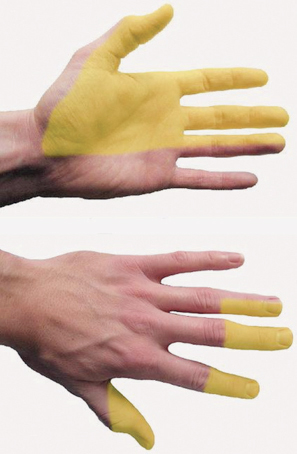66 What cervical roots form the brachial plexus? The brachial plexus is formed by the ventral rami of the C5-T1 spinal roots. Describe the organization of the supraclavicular, retroclavicular, and infraclavicular portions of the brachial plexus. Within the posterior triangle of the neck and between the anterior and middle scalenes, the five roots of the supraclavicular plexus form three trunks (superior, middle, and inferior). The retroclavicular plexus forms six divisions (anterior and posterior for each trunk). The infraclavicular plexus forms three cords (lateral, medial, and posterior—named in relation to the axillary artery), which end in five terminal nerves. Mnemonic: 5–3-6–3-5. Name the terminal nerves of the brachial plexus. • Lateral cord: musculocutaneous n. and lateral contribution to median n. • Medial cord: ulnar n. and medial contribution to median n. • Posterior cord: axillary and radial n. Fig. 66.1 Brachial plexus. What nerves branch directly from the cervical roots? 1. Dorsal scapular n. (C4-C5) to rhomboids and levator scapulae 2. Long thoracic nerve n. (C5–7) to serratus anterior What roots form the superior trunk? The C5 and C6 roots What terminal nerves branch directly from the superior trunk? Suprascapular n. and nerve to subclavius What root forms the middle trunk? The C7 root What roots form the inferior trunk? The C8 and T1 roots Do the middle and inferior trunks form any terminal nerve branches? No Do the six divisions of the brachial plexus form any terminal nerve branches? No What forms the lateral cord and what are its branches? The anterior divisions of the superior and middle trunks form the lateral cord. Branches: 1. Lateral pectoral n. (C5-C7; to pectoralis major and minor) 2. Musculocutaneous n. (C5-C7; to biceps brachii, brachialis, coracobrachialis) 3. Lateral contribution to the median n. What forms the medial cord and what are its branches? The anterior division of the inferior trunk forms the medial cord. Branches: 1. The medial pectoral n. (C8-T1; to pectoralis major and minor) 2. Medial brachial and antebrachial cutaneous n. 3. Ulnar n. (C7-T1) 4. Medial contribution to the median n. What forms the posterior cord and what are its branches? All three posterior divisions (each from the superior, middle, and inferior trunks) form the posterior cord. Branches: 1. Upper and lower subscapular n. (C5-C6; to subscapularis and teres major) 2. Thoracodorsal n. (C6-C8; to latissimus dorsi) 3. Axillary n. (C5-C6) 4. Radial n. (C5-T1) What are the boundaries of the quadrangular space? Lateral: humerus (surgical neck) Medial: long head of triceps Superior: teres minor (viewed posteriorly) subscapularis (viewed anteriorly) Inferior: teres major What are the boundaries of the triangular space? Lateral: humerus Medial: long head of triceps Superior: teres major What is the motor supply of the median nerve? Branches in forearm: • Pronator teres • Flexor carpi radialis (FCR) and palmaris longus (PL) • Flexor digitorum superficialis (FDS) • Via anterior interosseus n. to: Branches in hand: • Lumbricals 1 and 2 • Via recurrent branch of median n. to: What is the cutaneous sensory supply of the median nerve? • Palmar cutaneous branch: lateral aspect of palm • Cutaneous branches to palmar surface and sides of thumb, index, middle, and half of ring finger, and dorsum of distal half of these fingers Fig. 66.2 Cutaneous innervation of the median nerve in the hand.
Upper Extremity
66.1 Neuroanatomy

 Flexor digitorum profundus (FDP) 1 and 2
Flexor digitorum profundus (FDP) 1 and 2
 Flexor pollicis longus (FPL)
Flexor pollicis longus (FPL)
 Pronator quadratus (PQ)
Pronator quadratus (PQ)
 Abductor pollicis brevis (APB)
Abductor pollicis brevis (APB)
 Flexor pollicis brevis (FPB)—superficial head
Flexor pollicis brevis (FPB)—superficial head
 Opponens pollicis (OP)
Opponens pollicis (OP)

![]()
Stay updated, free articles. Join our Telegram channel

Full access? Get Clinical Tree






